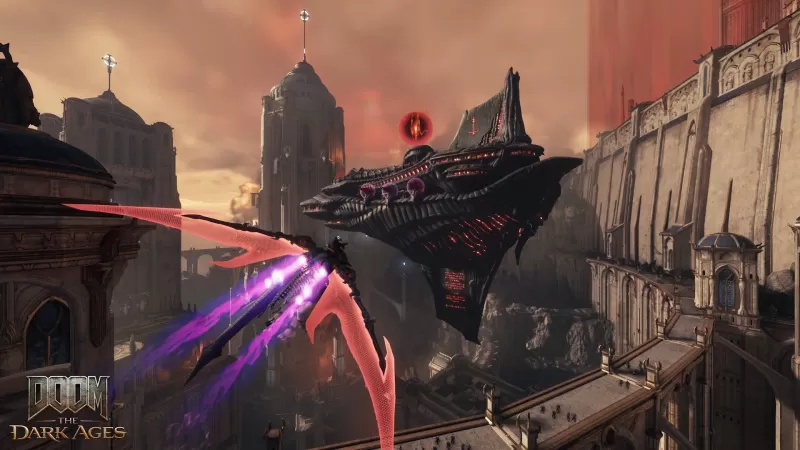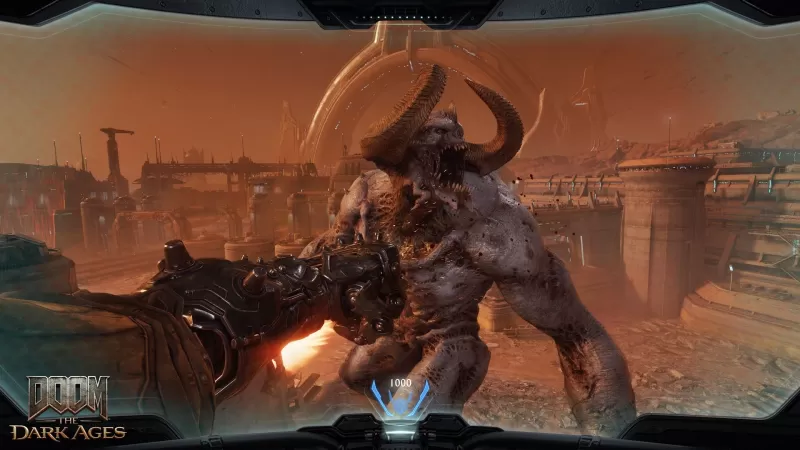During a hands-on demo of Doom: The Dark Ages, I found myself unexpectedly reminded of Halo 3. Mounted on the back of a cyborg dragon, I unleashed a barrage of machine gun fire against a demonic battle barge, obliterating its defensive turrets. After landing atop the vessel, I charged through its lower decks, transforming the crew into a bloody mess. Moments later, I burst through the hull, leaping back onto my dragon to continue my relentless assault on Hell's machines.
Fans of Bungie's iconic Xbox 360 shooter will recognize the similarity to Master Chief’s assault on the Covenant's scarab tanks. While the helicopter-like Hornet has been replaced with a holographic-winged dragon and the laser-firing mech with an occult flying boat, the essence remains: an aerial assault transitioning into a devastating boarding action. Surprisingly, this wasn't the only Halo-esque moment in the demo. Despite The Dark Ages' core combat being quintessentially Doom, the campaign's design evokes the late-2000s shooter vibe, featuring elaborate cutscenes and a push for gameplay novelty.

Over two and a half hours, I experienced four levels of Doom: The Dark Ages. The opening level echoed the tightly-paced, meticulously designed gameplay of Doom (2016) and its sequel. Subsequent levels involved piloting a colossal mech, flying the dragon, and navigating a vast battlefield with secrets and powerful minibosses. This represents a significant departure from Doom's traditional focus on mechanical purity, resembling more the likes of Halo, Call of Duty, and even old James Bond games like Nightfire, which are known for their scripted setpieces and novel mechanics.
It's a fascinating direction for Doom, considering the series once veered away from such elements. The cancelled Doom 4 was set to emulate Call of Duty with its modern military aesthetic, increased emphasis on characters, cinematic storytelling, and scripted events. Yet, id Software decided these ideas didn't fit Doom, leading to the focused approach of Doom (2016). Now, in 2025, these elements are back in The Dark Ages.
The campaign's rapid pace is interspersed with new gameplay ideas that echo Call of Duty's most innovative moments. My demo began with a long, detailed cutscene that reintroduced the realm of Argent D'Nur, the opulent Maykrs, and the Night Sentinels—the knightly allies of the Doom Slayer. Portrayed as a terrifying legend, the Slayer's lore is familiar to fans, yet the cinematic presentation feels fresh and reminiscent of Halo. This continues into the levels, with NPC Night Sentinels scattered throughout, akin to UNSC Marines, fostering a sense of being part of a larger force, much like Master Chief.
The introductory cutscene includes significant character development, raising questions about whether Doom needs this level of storytelling. Personally, I preferred the subtle narrative approach of previous games, conveyed through environmental design and codex entries. The Dark Ages' cutscenes, however, are brief, setting up missions without disrupting the game's intense flow.
The demo introduced other gameplay interruptions. Following the shotgun-heavy opening mission, I found myself in the cockpit of a Pacific Rim-inspired Atlan mech, battling demonic kaiju. Then, I soared through the skies on the cybernetic dragon, targeting battle barges and gun emplacements. These scripted levels introduce a significant shift, reminiscent of Call of Duty's novel sequences like Modern Warfare's AC-130 gunship or Infinite Warfare's dogfighting missions. The Atlan is slow and heavy, offering a unique perspective on Hell's armies, while the dragon is fast and agile, providing a distinct third-person experience far removed from traditional Doom gameplay.

Many top FPS campaigns thrive on such variety, with Half-Life 2 and Titanfall 2 setting the standard. Halo's enduring appeal partly stems from its mix of vehicular and on-foot sequences. However, I'm uncertain about this approach for Doom. The Dark Ages remains a complex shooter with every second demanding attention as you weave shots, shield tosses, parries, and brutal melee combos. In contrast, the mech and dragon sequences feel less engaging, almost resembling QTEs due to their tightly controlled combat.
In Call of Duty, switching to a tank or gunship works because the mechanical complexity isn't far from on-foot gameplay. But in The Dark Ages, there's a noticeable gap between gameplay styles, akin to a novice guitarist playing alongside Eddie Van Halen. While Doom's core combat remains the star, the mech and dragon sequences left me longing for the ground-level action with a double-barreled shotgun.
The final hour of my playthrough introduced "Siege," a level that refocuses on id's exceptional gunplay but expands into a vast open battlefield. The objective—to destroy five Gore Portals—echoes Call of Duty's multi-objective missions, yet it also reminded me of Halo, with its contrast between tight and expansive environments. This level challenges players to rethink weapon ranges, use charge attacks to cover vast distances, and employ shields against artillery from oversized tank cannons.
Expanding Doom's playspace can lead to a loss of focus, with backtracking and empty pathways disrupting the pace. I believe incorporating the dragon into this level, similar to Halo's Banshee, could maintain momentum and integrate the dragon more seamlessly into the experience.
The Dark Ages resurrects and reinterprets ideas once deemed unsuitable for Doom. The cancelled Doom 4 featured scripted setpieces and vehicle scenes, elements now present in the Atlan and dragon sections. Marty Stratton from id Software confirmed Doom 4's resemblance to Call of Duty, with more cinematic storytelling and characters. These elements, once discarded, are now central to The Dark Ages, featuring boarding action setpieces, lush cinematics, a broader cast, and significant lore reveals.
The question remains: were these ideas always a bad fit for Doom, or were they just ill-suited when they mimicked Call of Duty too closely? While skeptical, I'm also excited to see id Software potentially make this approach work within the modern Doom framework.
The core of The Dark Ages is undeniably its on-foot, gun-in-hand combat. Nothing in the demo suggested it wouldn't be the main focus, and everything I played confirmed it's another brilliant evolution of Doom's core. While I believe this alone could support an entire campaign, id Software has other plans. Some of the new ideas feel mechanically thin, raising concerns about their integration. However, there's still much to explore, and only time will contextualize these demo missions. I eagerly await May 15th, not just to return to id's unparalleled gunplay, but to see if Doom: The Dark Ages delivers a cohesive late-2000s FPS campaign or a disjointed one.



















